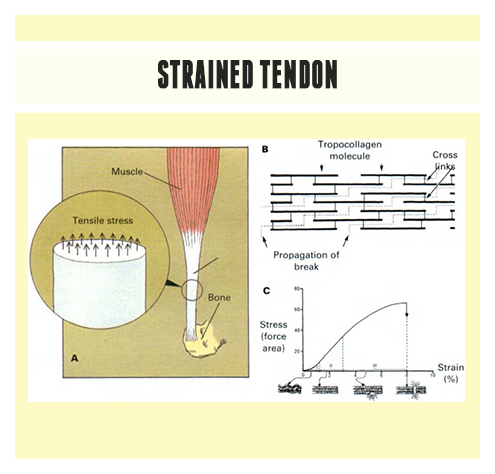The strained tendon is a common yet painful injury that will occur in almost everyone at least once in their lifetime. Many people will experience a strain to an ankle tendon at some point in their lives as we use our feet everyday for walking and other common activities.
The trick with a strained tendon is to make sure it heals properly which will provide the lowest chance of re-injury. Re-injury of a strained or stressed tendon occurs more easily than the initial injury and there is usually more inflammation around a re-injured tendon than there was during the first injury. A tendon strain left untreatedcan easily become a chronic problem that disrupts your ease of walking and participation in activities that you enjoy, something we often take for granted.
A strain that goes left untreated can cause more pain in the tendon and may be a sign of chronic tendonitis (also spelled tendinitis). Chronic tendonitis is a degenerative condition in the tendon fibres that attach the muscles to the bones in the ankle. Sufferers generally complain of a severe, burning pain in the area, which gradually worsens and is exacerbated by stress on the joint.
Grades of Tendon Strains
A tendon or muscle can be strained to varying degrees depending on the force that caused the strain and the strength of the tendon or muscle tissue. There are 3 difference grades of tendon strains and the grade is determined by the severity of the tissue damage.
Grade 1 – Mild Strain
A grade 1 strain is the least serious of tendon strains. With a grade 1 strain there is some stretching or minor tearing of the tendon tissue. These injuries usually heal quickly if treated properly with cold compression and Blood Flow Stimulation Therapy™ (BFST®). When the strain first occurs, treat it immediately with cold compression therapy over the course of the first 48 hours to reduce pain, swelling, and tissue damage. Once the strain or tear has healed, it is important to improve the health of the tendon and restore the elasticity to the tendon with Blood Flow Stimulation Therapy™ to reduce the risk of restraining it again.
Grade 2 – Moderate Strain
A grade 2 strain occurs when a tendon or muscle is partially torn but still intact. If you have a grade 2 strain, strength in the ankle tendon is noticeably reduced. This grade of strain can also be effectively treated with cold compression and BFST®. It is also recommended that you allow your ankle to rest and possibly wear a brace to immobilize the ankle and allow the tendon tear to heal.
Grade 3 – Rupture or Severe Strain
When a tendon is completely torn (ruptured) it is considered a grade 3 tear. The stability of the ankle is greatly reduced and pain is evident. Treatment of a complete tendon tear requires surgery to rejoin the tendon to the bone or back together at the point of the tear on the tendon. Cold compression and BFST® can be used prior to surgery to minimize tissue damage, resulting in a less invasive surgery.
In addition, using these therapies following surgerywill help to repair and strengthen the tendon fasterand more completely. With these therapies you will have less scar tissue formation on your ankle tendon leaving it more elastic and less painful than if it was left to heal on its own.
Tendon Strain Symptoms
If you have suffered a tendon strain you may be experiencing the following symptoms:
- Pain in your tendon when you flex or extend your foot.
- Muscle spasm in the gastrocnemius and soleus muscles of the calf.
- Pain and tenderness may occur when the tendon is examined by touch (palpated).
- Swelling
- Noticeable loss of strength in a grade 2 or 3 tendon strain.
Causes of Tendon Strain
A strain in the tendon is caused by excessive twisting and turning, rolling over on the ankle, a sudden traumatic injury, improper training oroveruse during a prolonged period of time.
Whether you are a runner/athlete, painting on a ladder, or walking on ice, an unfortunate twist and awkward fall can cause you to strain a tendon in your ankle if it is twisted abnormally. As well, using your ankle when it is not warmed up properly (i.e. sprinting or overstretching it before the fibres are warm) can also lead to an acute strain.
Ankle Tendon Treatments
Allowing your ankle to rest is always recommended when you are suffering from tendinitis, tendon tear or bone dislocation. Avoid all activities that may have caused the injury or irritation and begin cold compression treatments as soon as possible. The peroneal and posterior tibial tendons are difficult to rest completely as they are essential tendons for walking and daily activities. During your recovery, you will probably have to modify and/or eliminate any activities that cause pain or discomfort in your ankle until the pain and inflammation settle.
The trick with healing an ankle tendon injury is getting it to heal with minimal scar tissueformation. Even with optimum healing, there is always less elasticity in previously injured peroneal tendons. This will cause the tendons to hurt during daily activities and exercise. However, if you heal your ankle tendons efficiently and quickly, your chance of re-injury later on is much lower than average.
Fortunately, there are healing tools that can help treat your peroneal and posterior tibial tendons and speed up the healing process so you can get back to a life without pain and risk of further injury. Blood Flow Stimulation Therapy™ (BFST®) promotes blood flow to heal your tendons faster and more completely than any other methods available.
